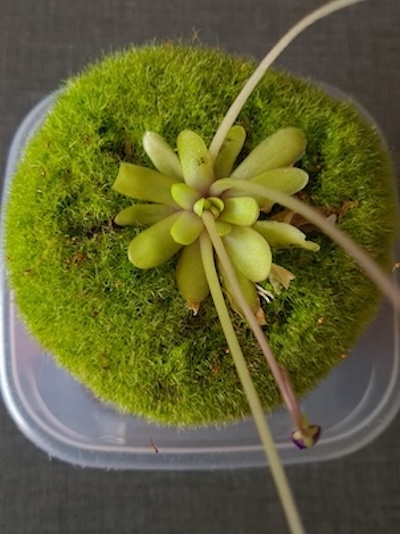

Pinguicula x 'Anna'
General
Pinguicula x 'Anna' is a charming hybrid butterwort, loved by collectors and beginners alike for its prolific growth and striking appearance. This carnivorous beauty is the result of crossing different Pinguicula species, selectively bred to enhance ornamental traits and adaptability. It's equally at home on a bright windowsill as it is in a specialized collection, thanks to its resilience and minimal care requirements.
Physical Characteristics
The plant forms compact, attractive rosettes of fleshy, bright lime-green to yellowish leaves, which are often slightly glossy due to their covering of glandular hairs. These sticky hairs trap small insects, supplementing the plant’s diet. During the growing season, the rosette can reach up to 12 cm (about 5 inches) across. Its flowers are a highlight—delicate, typically pale purple to lavender with a white throat, blooming singly on slender stalks above the foliage.
Lifestyle
A natural-born insect catcher, this butterwort relies on the gluey secretions of its leaves to attract, trap, and digest small prey, mainly fruit flies and gnats. While it photosynthesizes like a typical plant, the added nutrients from insects help it to thrive in nutrient-poor conditions where it would otherwise struggle.
Habitat and Protection
As a cultivated hybrid, this plant doesn’t occur in the wild but is derived from species native to Europe, Central America, and North America. These parent species are typically found in boggy, rocky, or mossy environments with high humidity and good air circulation. While fairly robust in cultivation, it still needs protection from freezing temperatures, direct midday sun, and pests such as aphids or fungus gnats.
Cultivation
Growing this plant is straightforward, making it an ideal choice for anyone exploring the fascinating world of carnivorous plants. It thrives in containers indoors or in sheltered outdoor settings in mild climates. The key is providing soft water, bright filtered light, and avoiding nutrient-rich soils.
Special Features
- Abundant flowering: Well-grown specimens often bloom multiple times a year.
- Color shifts: Leaves sometimes develop alluring pinkish or red tones under intense light.
- Simple propagation: Easily multiplied by leaf pullings or division, making it a rewarding plant for sharing or expanding your collection.
Care
Light
Prefers bright, indirect light, such as an east or north-facing windowsill. Some gentle morning sun is beneficial, but harsh afternoon rays can scorch the leaves.
Temperature
Ideal temperature range is 15–25°C (59–77°F). It can tolerate brief drops to 5°C (41°F) but should be protected from prolonged cold.
Water
Use only rainwater, distilled, or reverse osmosis water. Keep the soil moist but never soaking; a shallow tray with a few millimeters of water during the growing season works best. Never let the pot sit in water during winter.
Soil
Plant in an airy mix, typically 2 parts peat or sphagnum moss to 1 part perlite or sand. Avoid standard potting compost as it’s too rich.
Nutrition
Fertilizer is rarely needed—let it catch its own bugs! If growth lags, a very dilute orchid fertilizer (one-quarter strength) can be applied sparingly, once a month in summer.
Humidity
Moderate to high humidity (50–70%) is optimal but the plant tolerates slightly lower room humidity if watered regularly.
Dormancy
Usually doesn’t require a marked dormancy; however, it may slow down in the cooler months and produce smaller, tighter leaves. Reduce watering slightly during this time.
Common Problems
Leaves discolor or burn
Cause: Too much direct sunlight without gradual acclimatization.
Solution: Allow the plant to gradually get used to brighter light by slowly increasing its exposure to direct sunlight.
Brown leaf edges
Cause: Hard tap water or excessive fertilizer concentration.
Solution: Use only soft (rain/demineralized) water and do not use chemical fertilizer.
No sticky droplets on leaves
Cause: Air is too dry or plant is stressed.
Solution: Increase humidity and ensure the plant is not exposed to drafts or direct heat sources.
Failure to flower
Cause: Insufficient light or excessive feeding.
Solution: Move the plant to a brighter spot and reduce feeding; allow it several months of slightly cooler, shorter days in winter.
